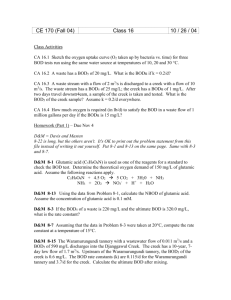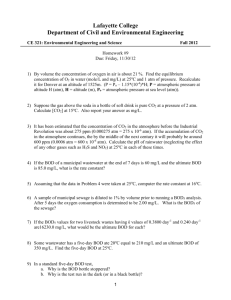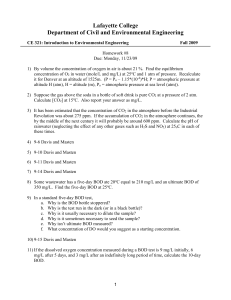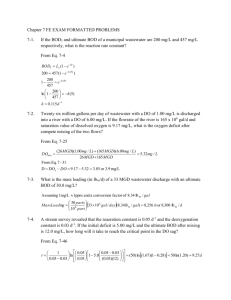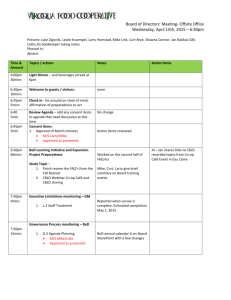L t - Sites at Lafayette
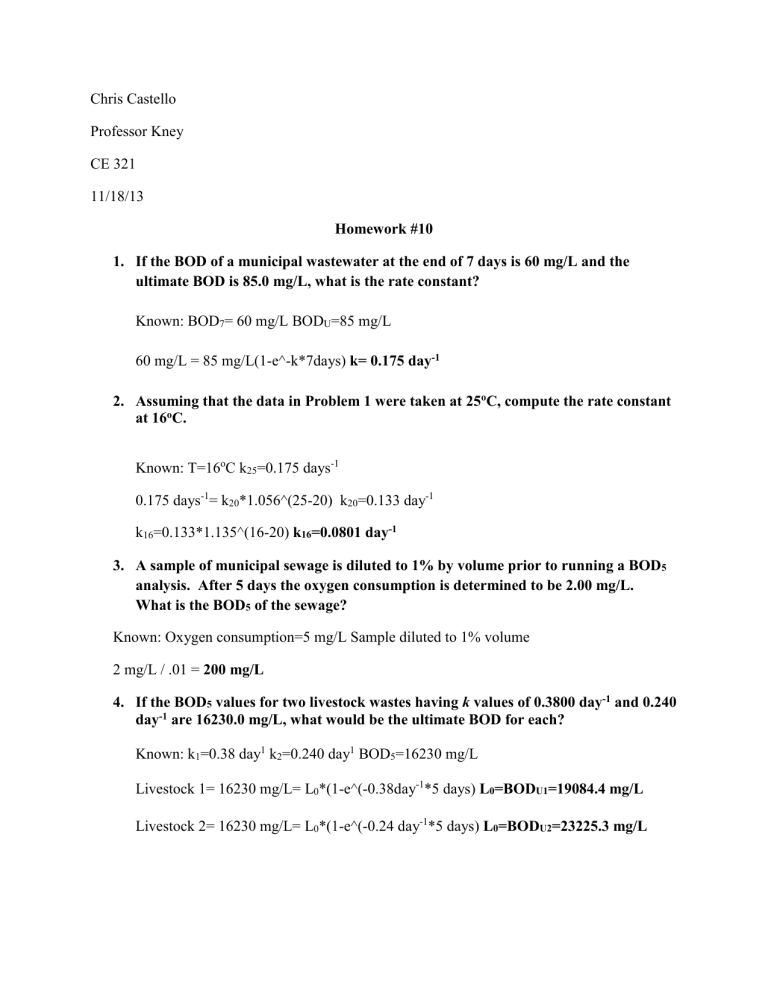
Chris Castello
Professor Kney
CE 321
11/18/13
Homework #10
1.
If the BOD of a municipal wastewater at the end of 7 days is 60 mg/L and the ultimate BOD is 85.0 mg/L, what is the rate constant?
Known: BOD
7
= 60 mg/L BOD
U
=85 mg/L
60 mg/L = 85 mg/L(1-e^-k*7days) k= 0.175 day -1
2.
Assuming that the data in Problem 1 were taken at 25 o C, compute the rate constant at 16 o C.
Known: T=16 o
C k
25
=0.175 days
-1
0.175 days
-1
= k
20
*1.056^(25-20) k
20
=0.133 day
-1 k
16
=0.133*1.135^(16-20) k
16
=0.0801 day -1
3.
A sample of municipal sewage is diluted to 1% by volume prior to running a BOD
5 analysis. After 5 days the oxygen consumption is determined to be 2.00 mg/L.
What is the BOD
5
of the sewage?
Known: Oxygen consumption=5 mg/L Sample diluted to 1% volume
2 mg/L / .01 = 200 mg/L
4.
If the BOD
5
values for two livestock wastes having k values of 0.3800 day -1 and 0.240 day -1 are 16230.0 mg/L, what would be the ultimate BOD for each?
Known: k
1
=0.38 day 1 k
2
=0.240 day 1 BOD
5
=16230 mg/L
Livestock 1= 16230 mg/L= L
0
*(1-e^(-0.38day
-1
*5 days) L
0
=BOD
U1
=19084.4 mg/L
Livestock 2= 16230 mg/L= L
0
*(1-e^(-0.24 day -1 *5 days) L
0
=BOD
U2
=23225.3 mg/L
5.
A wastewater has a five-day BOD equal to 210 mg/L (test performed at 20 o C) and an ultimate BOD of 350 mg/L. Find the five-day BOD at 25 o C.
Known: BOD
5
= 210 mg/l at 20 C L
0
=350 mg/L at 25 C
210 mg/L = 350 mg/L * (1-e^(-k *5) k
20
= 0.183 day -1 k
25
=.183*1.056^(25-20)=.240 day
-1
BOD
5 at 25 degrees C= 350 mg/L *(1-e^-.24 * 5)= 244.58 mg/L
6.
In a standard five-day BOD test, a.
Why is the BOD bottle stoppered?
The BOD test bottle is stoppered to ensure that the system is closed. b.
Why is the test run in the dark (or in a black bottle)?
The test run is done in the dark or in a black bottle to ensure there is no sunlight getting into the bottle. This is to make sure organic materials can’t grow. c.
Why is it usually necessary to dilute the sample?
The oxygen demanded from the organisms is in the dissolved water. The maximum oxygen that can dissolve is 9 mg/L. This means BOD samples need to be diluted to 2-7 mg/L. d.
Why is it sometimes necessary to seed the sample?
It is necessary to provide micro-organisms to oxidize organic matter. e.
Why isn’t ultimate BOD measured?
Measuring ultimate BOD would take too much time as the curve begins to flatten out shortly after 5 days. f.
What concentration of DO would you suggest as a starting concentration?
9 mg/L is the suggested initial dissolved oxygen.
7.
Assuming 0.1 mM of glutamic acid (C
5
H
9
O
4
N) is used in the following stoichiometric reactions, calculate the Theoretical NBOD of glutamic acid.
C
5
H
9
O
4
N + 4.5O
2
5CO
2
+ 3H
2
O + NH
3
NH
3
+ 2O
2
NO
3
-
+ H
+
+ H
2
O
.1 mmol/L * 1mol/1000mmol * 147 g/mol * 1000 mg/g = 14.7 mg/L glutamic acid
(14.7 mg/L glutamic acid * 62 g/mol NO
3
-
) / 147 g/mol glutamic acid= 6.2 mg/L NO
3
-
6.2 mg/L NO
3
* (14 g/moi N/62 g/mol NO
3
)= 1.4 mg/L N
1.4
mg/L N * 4.57 mg O
2
/mg N= 6.4 mg O
2
/L
8.
If the dissolved oxygen concentration measured during a BOD test is 9 mg/L initially, 6 mg/L after 5 days, and 3 mg/L after an indefinitely long period of time, calculate the 10-day BOD.
Known: DO i
= 9 mg/L DO
5
=6mg/L DO f
=3 mg/L
Assumption: No given sample size- ASSUME 10mL sample
BOD
5
= (9 mg/L – 6 mg/L)/ (10mL/300mL)= 90 mg/L
L
0
= (9 mg/L – 3 mg/L) / (10mL /300mL) = 180 mg/L
90 mg/L= 180 mg/L * (1-e^-k *5 days) k=.139 day
-1
BOD
10
= 180 mg/L * (1-e^-.139 day
-1
* 10 days) = 135.17 mg/L
9.
The following figure shows a plot of BOD remaining versus time for a sample of the effluent taken from a wastewater treatment plant. a.
What is the ultimate BOD (L o
)?
L
0
= 40 mg/L b.
What is the five-day BOD?
BOD
5
= 40 - 15 mg/L = 25 mg/L
What is L t
for 7 days?
L t
10 mg/L
10.
If the BOD
5
for some wastewater is 200 mg/L and the ultimate BOD is 300 mg/L, find the reaction rate constant k (base e) and K (base 10).
Known: BOD
5
= 200 mg/L L
0
= 300 mg/L
200 mg/L = 300 mg/L * (1-e^(-k * 5 days) k= 0.22 day -1
200/L = 300 mg/L * (1-10^(-K * 5 days) K= 0.095 day -1
11.
Suppose a wastewater has a BOD
5
equal to 180 mg/L and a reaction rate (k) equal to
0.22/day. a.
Find the ultimate carbonaceous oxygen demand (CBOD).
180 mg/L= L
0
(1-e^(-0.22 day
-1
* 5 days)) L
0
=269.8 mg/L b.
Find the remaining BOD after five days have elapsed.
269.8mg/L – 180 mg/L = 89.8 mg/L
12.
Glutamic acid (C
5
H
9
O
4
N) is used as one of the regent for a standard to check the
BOD test. Determine the theoretical oxygen demand of 150 mg/L of glutamic acid.
Assuming the following reactions:
C
5
H
9
O
4
N + 4.5O
2
5CO
2
+ 3H
2
O + NH
3
NH
3
+ 2O
2
NO
3
+ H + + H
2
O
150 mg/L glutamic acid * 4.5(32 g/mol O
2
) / 147 g/mol glutamic acid = 146.9 mg/L O
2
150 mg/L glutamic acid * 17 g/mol NH
3
) / 147 g/mol glutamic acid = 17.35 mg/L NH
3
17.35 mg/l NH
3 *
2(32 g/mol O
2)
/ 17 g/mol NH
3
= 65.32 mg/L O
2
146.9 mg/L + 65.32 mg/L= 212.12 mg/L O
2
= THOD
13.
10.0 ml sample of wastewater with enough water to fill a 300 ml bottle has an initial
DO of 9.0 mg/L. To help assure an accurate test, it is desirable to have at least a 2.0 mg/L drop in DO during the five day run, and the final DO should be at least 2 mg/L. For what range of BOD
5
would this dilution produce the desired results.
Assume this test to be a five-day, unseeded BOD test.
Known: 10mL sample, 300 mL bottle, DO i
=9 mg/L DO f
= 2,7 mg/L
BOD
5
= (9 mg/L – 2 mg/L) / (10mL/300mL)= 210 mg/L
BOD
5
= (9 mg/L – 7 mg/L) / (10mL/300mL)= 60 mg/L
Range= 60 mg/L to 210 mg/L
14.
A water sample is diluted by a factor of 10 using seeded dilution water. Dissolved oxygen concentration is measured at 1-d intervals, and the results are listed below.
Using these data, determine the BOD as a function of time, i.e., calculate the BOD for each day.
Known: Dilution factor=P= 0.1
Assume 300 mL bottle, 30 mL sample f= % seed in diluted sample/ %seed water in control sample= 90% / 100% = 0.9
Day 1= (8.55-4.35)-f (8.75-8.70) / .1 = 44.55 mg/L
Day 2=(8.55-4.05)-f (8.75-8.66) / .1= 44.19 mg/L
Day 3=(8.55-3.35)-f (8.75-8.61) / .1= 50.74 mg/L
Day 4=(8.55-2.75)-f (8.75-8.57) / .1= 56.38 mg/L
Day 5=(8.55-2.40)-f (8.75-8.53) / .1=59.52 mg/L
Day 6=(8.55-2.10)-f (8.75-8.49) / .1= 62.16 mg/L
Day 7=(8.55-1.85)-f (8.75-8.46) / .1= 64.39 mg/L
